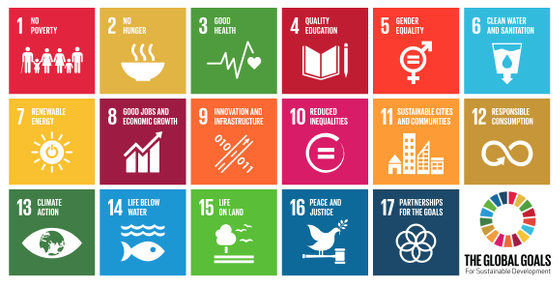Fabiola Riccardini on developing indicators for the Sustainable Development Goals (SDGs)

date: 29/06/2016
Fabiola Riccardini is the Head of the Well-Being and Sustainability Unit at the Italian National Institute for Statistics (ISTAT). She was Co-Chair of the Inter-agency and Expert Group on Sustainable Development Goal Indicators, in which she currently represents Italy, and cooperates with the United Nations High Level Group for Global Partnership and Capacity Building for post 2015 monitoring. She also teaches at the University of Perugia (Italy) subjects including measurements of sustainability and well-being, quality of life indicators and beyond GDP indicators. At the OECD Statistics Directorate she worked on well-being and sustainability measures and was Co-Chair of the Information Economy Working Party.
Why is it necessary to develop a set of indicators to monitor the SDGs implementation? Is it reasonable to define them at global level?
Measurement is an essential aspect of monitoring, allowing an objective and comparable tracking of the progress countries achieve towards the goals. That’s why indicators associated to the goals are absolutely needed. A global indicators framework responds to the commitment of Heads of State to engage in a systematic review and follow up of the 2030 Agenda for Sustainable Development and SDGs implementation. The UN Secretary General will prepare an annual progress report on SDGs based on the global indicator framework. Data produced by the national statistical systems will feed into the database maintained by the Statistics Division of the United Nations Department for Economic and Social Affairs (UNDESA). The monitoring framework will also be implemented at regional and national level. Countries will be responsible for monitoring at national level, on regular and voluntary basis.
How can we ensure a wide acceptance of the SDGs indicators, despite the cultural, social and environmental differences existing across the world?
Two specific working groups organised by the UN Statistical Commission guarantee a balanced dialogue between countries. On one hand, the Inter-agency and Expert Group on the SDG Indicators has to identify the indicators’ framework for goals and targets monitoring. On the other hand, the High Level Group for Partnership, Coordination and Capacity Building for Post-2015 has to establish a global partnership for sustainable development and reporting, increase capacity building and lead the SDGs implementation process. Similar groups, which were not established for the Millennium Development Goals, were implemented under the responsibility of National Statistical Institutes (NSIs). A dedicated and open website is available for both groups.
What are the limitations of identifying the SDG indicators and monitoring framework after having agreed on goals and targets?
Some targets are formulated in a way which makes them difficult to measure, for instance where they are too general or multidimensional. However, in practice, the discussion on SDG indicators started during the formulation of the goals and targets, in order to take into account statistical measurability. Since the SDGs indicators framework provides mechanisms for implementation review and verification, the High Level Political Forum could in principle also revise some targets if they are found not easily measurable.
Why is a public consultation on SDG indicators important? How has this contributed to the selection of preliminary indicators?
Public consultation is an important step for indicator selection, as it allows to consider different actors’ views. An inclusive agenda, aiming at building trust and confidence among data users, has to include a process for identifying measures reflecting the different components of society. This is what the UN Statistical Commission has been trying to achieve in developing the SDG indicators. Over the past months and on several occasions, the consultation on indicators along with the NSIs was open also to civil society, academia, businesses and other relevant stakeholders.

How can a culturally based concept like well-being be accounted for at global level, in spite of such differences?
Under target 17.19 (by 2030, build on existing initiatives to develop measurements of progress on sustainable development that complement GDP, and support statistical capacity building in developing countries), there is room for a measure of progress which could include well-being. Currently, there is no official worldwide agreement about this indicator, due to its multi-dimensionality. However, this is certainly a step forward towards a wider debate on how a suitable well-being indicator can be selected.
Several targets, like for instance those related to Goal 12 on Sustainable Consumption, will imply bigger challenges to wealthier countries than for the other ones. Do you expect indicators related to these targets (e.g. per capita material footprint or per capita food waste) to be reported on by national statistical offices and/or used for national policies?
Measures such as the per capita material footprint and per capita food waste are still being debated. In Europe, such measures are already being experimented with by countries in the context of the System of Environmental-Economic Accounting (SEEA). Currently, from around 230 indicators identified, 80 indicators still need further discussion for a consensus to be reached and a suitable methodology defined. The proposal for the global indicators set has been adopted by the UN Statistical Commission in its forty-seventh session in March 2016 and then by the UN Economic and Social Council (ECOSOC). The global indicators set for the SDGs is expected to be adopted by the UN General Assembly in September 2016.
How are the UN Data Revolution Report and new data sources going to influence the choice of SDGs indicators?
In November 2014, the Secretary-General’s Independent Expert Advisory Group (IEAG) published the report ‘A World That Counts: Mobilising the Data Revolution for Sustainable Development’, whose conclusions are in line with the ongoing work.
The recommendations given in this report underline the need for increasing the statistical capacity of countries in order to develop a global consensus on principles and standards and leadership for coordination and mobilization. The challenge of new data production will certainly spur the modernization of national statistical systems in terms of processes, products and sources.
Concerning new data sources, for example, national statistical offices are exploring the role of big data and the opportunities they could generate, still following the UN Fundamental Principles for Official Statistics to ensure the integrity of this information. Many statistical offices are currently experiencing a modernisation process and looking at the possibilities new data and technology can provide. All available data sources are taken into account while ensuring data quality.
Some SDGs targets are formulated at micro level (companies and businesses) rather than at macro level (national policy-making). How can private actors be encouraged to report on their progress?
Today, companies are aware that they are operating in a changing business environment where consumers require higher social and environmental standards. Already, the UN Global Compact initiative has involved thousands of companies to align with virtuous behaviours. Sustainability is becoming an increasingly relevant criterion for evaluating business performance, as proven by companies’ accounting practices. The Global Reporting Initiative (GRI), launched in 1997 and supported by UNEP, is an attempt to standardise companies’ reporting, taking into account sustainability criteria. The SDGs framework includes a target (12.6 - encourage companies, especially large and trans-national companies, to adopt sustainable practices and to integrate sustainability information into their reporting cycle) about companies’ sustainability reporting, covering not only economic aspects but also social and environmental ones. Therefore, the business sector is showing an increasing attention to themes covered by the SDGs.
Since the SDGs are a challenge for the entire world, they need to be clearly understood and appropriate actions need to be taken in order to achieve them. There are no alternatives to a more equitable and sustainable planet. Although the 2030 Agenda for Sustainable Development is very ambitious, the risks we are facing call for the fruitful contribution of all actors involved.
